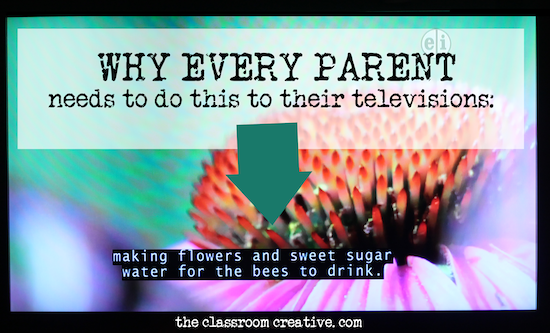Back when I was teaching second grade, I had the fortunate experience of attending a professional development by author and reading guru Jim Trelease, author of The Read-Aloud Handbook.
As educators, we’ve all been to many a conference, but it speaks volumes when nearly a decade later, his words are still as vibrant as the day he spoke them. If only all educators had that impact!
One of the tidbits he shared, I want to shout from the rooftops and have ALL parents with children who are school-aged need to start TODAY.
Close-caption your televisions.
If I had a million bucks, I’d buy some billboards RIGHT NOW.
I grew up with deaf grandparents, so seeing the television close-captioned was very common in my childhood. I remember “reading the TV” as young as age 4. Starting in the 1990s, it was federally mandated that ALL televisions are outfitted with the ability to close-caption. Perhaps, it was one of the reasons I was an early reader.
According to Jim Trelease, it is.
“It appears that reasonable doses of captioned television can do no harm and most likely help with reading. Research among 9 year olds in Finland appear to confirm this. These children are the highest scoring readers in the world, but they also spend more time watching TV than reading.”Given the American obsession with test scores, schools needs to educate parents on this SIMPLE change! Sounds like most American students I know: engaging more with media than with digging their noses in the newest novel.
What makes Finnish kids’ TV different?
50% of Finnish television programs are subtitled!
So what if my child can already read?
My youngest son reads the television. He is reading at a first grade level now at age 4. Sure, I’m an awesome parent who has been reading to him since he was a fetus, and I have more books in my home than most libraries, BUT, I credit a great deal of his early reading success to close-captioning my television.
Obsessively. To the point of irritating all of my other family members: BE SURE TO TURN ON THE CLOSE-CAPTIONING!
Think about it. Close-captioning your television is like a talking book. Eventualy, kids pick up on it: the relationship between the spoken and written word.
Trust me, they do. With the insane amounts of television some kids watch, close-captioning would level the playing field for ALL kids. So, for the children who are parked in front of televisions (who have parents that either can’t read in English or choose not to read to them)this could be a godsend.
Now that my youngest son is nearing kindergarten, I’m thrilled that many of the choices I made in terms of creating an ideal learning environment are paying off with high dividends.
Please help us spread the word about this!
A close-caption television revolution!
Pin it! Tweet it! Facebook it!
A simple change to a setting on our DVR boxes
can change our passive television viewers into readers!
Stay tuned for more ideas on our new series:
Growing A Reader: Tips and Ideas for Parents and Teachers
Have an emerging reader? Try these seasonal and holiday inspired resources! Below is an example of our spring collection.
Stay connected with us at The Classroom Creative:
- Google :: Instagram :: bloglovin’
- Facebook :: Pinterest :: Twitter
- Email :: Teachers Pay Teachers
Now, go close-caption your television!
Nicolette
(This post my contain affiliate links to Amazon and links to our TpT shop.
Thank you for supporting our blog.)












Great post! We at Captions for Literacy are also enthusiastic about getting parents (and teachers!) to turn on the captioning. We have lots of information about the research supporting this, as well as a list of places to find captioned educational videos online, at our site: http://captionsforliteracy.org. (And we accept donations to buy those billboards, even if you don’t have a million bucks. 😉